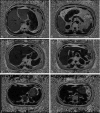Noninvasive fat quantification of the liver and pancreas may provide potential biomarkers of impaired glucose tolerance and type 2 diabetes
- PMID: 27281097
- PMCID: PMC4907675
- DOI: 10.1097/MD.0000000000003858
Noninvasive fat quantification of the liver and pancreas may provide potential biomarkers of impaired glucose tolerance and type 2 diabetes
Erratum in
-
Erratum: Medicine, Volume 95, Issue 23: Erratum.Medicine (Baltimore). 2016 Jul 18;95(28):e0916. doi: 10.1097/01.md.0000489580.04709.16. eCollection 2016 Jul. Medicine (Baltimore). 2016. PMID: 31265603 Free PMC article.
Abstract
The aim of the study is to investigate if the fat content of the liver and pancreas may indicate impaired glucose tolerance (IGT) or type 2 diabetes mellitus (T2DM). A total of 83 subjects (34 men; aged 46.5 ± 13.5 years) were characterized as T2DM, IGT, or normal glucose tolerant (NGT). NGT individuals were stratified as <40 or ≥40 years. Standard laboratory tests were conducted for insulin resistance and β-cell dysfunction. The magnetic resonance imaging Dixon technique was used to determine fat distribution in the liver and pancreas. Correlations among liver and pancreatic fat volume fractions (LFVFs and PFVFs, respectively) and laboratory parameters were analyzed. Among the groups, fat distribution was consistent throughout sections of the liver and pancreas, and LFVFs closely correlated with PFVFs. LFVFs correlated more closely than PFVFs with insulin resistance and β-cell function. Both the LFVFs and PFVFs were the highest in the T2DM patients, less in the IGT, and least in the NGT; all differences were significant. The PFVFs of the NGT subjects ≥40 years were significantly higher than that of those <40 years. The fat content of the liver and pancreas, particularly the liver, may be a biomarker for IGT and T2DM.
Conflict of interest statement
The authors have no conflicts of interest to disclose.
Figures





References
-
- Thomas EL, Fitzpatrick JA, Malik SJ, et al. Whole body fat: content and distribution. Prog Nucl Mag Res SP 2013; 73:56–80. - PubMed
Publication types
MeSH terms
Substances
LinkOut - more resources
Full Text Sources
Other Literature Sources
Medical

